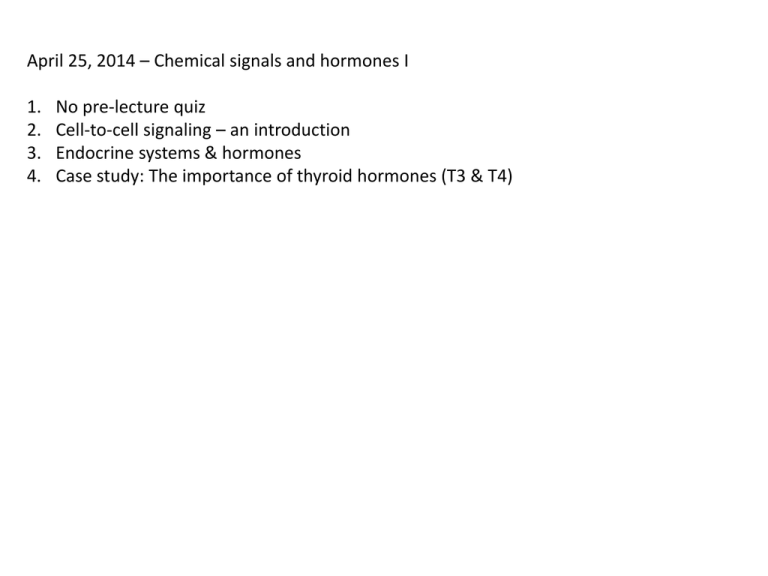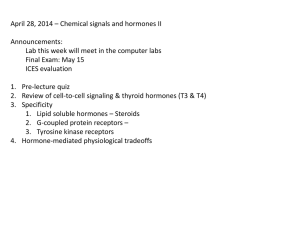
April 25, 2014 – Chemical signals and hormones I
1.
2.
3.
4.
No pre-lecture quiz
Cell-to-cell signaling – an introduction
Endocrine systems & hormones
Case study: The importance of thyroid hormones (T3 & T4)
Introduction to chemical signals in animals – Major categories
Endocrine
cells may be
organized
into glands
Autocrine signals
Paracrine signals
Endocrine signals
act on the same cell
that secretes them.
diffuse locally and act
on neighboring cells.
are hormones carried
between cells by blood
or other body fluids.
Introduction to chemical signals in animals – Major categories
Neurotransmitters
Neural signals
diffuse a short distance
between neurons.
Neuroendocrine signals
Pheromones
are released from neurons
but are carried by blood or
other body fluids and act
on distant cells.
are released into the
environment and act
on a different individual.
Endocrine systems are regulated by negative feedback
Endocrine pathway
Neuroendocrine pathway
Stimulus
Neuroendocrine-to-endocrine pathway
Stimulus
Stimulus
Endocrine cell
Endocrine
signal
Effector
cell
Response
Sensor cell
Sensor cell
Neural signal
Neural signal
CNS
CNS
Neuroendocrine
signal
Effector
cell
Response
Neuroendocrine
signal
Endocrine cell
Endocrine
signal
Effector
cell
Response
Chemical characteristics of hormones – major classes
Peptides and Polypeptides
Secretin
Amino Acid
Derivatives
Steroids
Cortisol
Epinephrine
Receptor
Receptor
Not lipid soluble;
bind to receptors on
surface of target cell
Target cell
Most not lipid soluble;
bind to receptors on
surface of target cell
Lipid soluble;
bind to receptors
inside target cell
Receptor
Hormone Transport and Action on Target
Hydrophobic messengers pass into
cell where they bind with
transcription factors which affect
gene expression.
Hydrophilic hormones bind to a
receptor on the cell membrane
which causes several reactions
known as a signal transduction
pathway. This can affect the
properties of enzymes/proteins, etc.
or it may affect gene expression.
This picture shows a hormone traveling through
the cell membrane and binding with a transcription factor.
Which of the following statements are true?
A) This is a membrane soluble (hydrophobic) hormone that
alters gene transcription.
B) This is a membrane soluble (hydrophobic) hormone that
alters immediate enzyme activity and cell processes.
C) This is a membrane insoluble (hydrophilic) hormone that
alters gene transcription.
D) This is a membrane insoluble (hydrophilic) hormone that
alters immediate enzyme activity and cell processes.
Barry Bonds was accused of using a steriod ‘the cream’ to increase his athletic
performance. He supposedly applied this to his skin. What does this tell you about the
nature of this hormone?
A.
B.
C.
D.
The hormone was membrane insoluble.
The hormone was membrane soluble.
The hormone initiated a signal transduction pathway.
A and C
Major endocrine glands
Polypeptides
Amino acid derivatives
Steroids
Figure 47-3-1
Hypothalamus
Growth-hormone-releasing hormone:
stimulates release of GH from pituitary
gland
Corticotropin-releasing hormone (CRH):
stimulates release of ACTH from pituitary
gland
Thyroid-releasing hormone: stimulates
release of TSH from thyroid gland
Gonadotropin-releasing hormone:
stimulates release of FSH and LH from
pituitary gland
Antidiuretic hormone (ADH): promotes
reabsorption of H2O by kidneys
Oxytocin: induces labor and milk release
from mammary glands in females
Polypeptides
Amino acid derivatives
Steroids
Figure 47-3-3
Polypeptides
Amino acid derivatives
Steroids
Pituitary gland
Growth hormone (GH): stimulates
growth
Adrenocorticotropic hormone (ACTH):
stimulates adrenal glands to secrete
glucocorticoids
Thyroid-stimulating hormone (TSH):
stimulates thyroid gland to secrete
thyroxine
Follicle-stimulating hormone (FSH)
and luteinizing hormone (LH): involved
in production of sex hormones;
regulate menstrual cycle in females
Prolactin: stimulates mammary gland
growth and milk production in females
Figure 47-3-2
Polypeptides
Amino acid derivatives
Steroids
Thyroid gland
Thyroxine: increases metabolic rate
and heart rate; promotes growth
Adrenal glands
Epinephrine: produces many effects
related to short-term stress response
Cortisol: produces many effects related to
short-term and long-term stress responses
Aldosterone: increases reabsorption of
Na+ by kidneys
Kidneys
Erythropoietin (EPO): increases
synthesis of red blood cells
Vitamin D: decreases blood Ca2+
Testes (in males)
Testosterone: regulates development
and maintenance of secondary sex
characteristics in males; other effects
Figure 47-3-4
Polypeptides
Amino acid derivatives
Steroids
Parathyroid glands
Parathyroid hormone (PTH):
increases blood Ca2+
Pancreas (islets of Langerhans)
Insulin: decreases blood glucose
Glucagon: increases blood glucose
Ovaries (in females)
Estradiol: regulates development and
maintenance of secondary sex
characteristics in females; other effects
Progesterone: prepares uterus for
pregnancy
Thyroid Hormone
Thyroid hormone:
- Actually two hormones (T3/T4)
Mammals mainly secrete T4
- but some T4 is converted under certain
circumstances
- Same receptor binds both,
but ↑affinity for T3
T3/T4 are membrane soluble
- ↑metabolism in muscles, heart, liver & kidney
T4
T3
Thyroid Gland
Low levels of iodine cause ~90% of goiters.
Why?
Figure 47-8
T3
T3
Juvenile frog (tadpole)
Adult frog
Locomotion
Swim via movements of muscular tail
Locomotion
Tailless; walk or hop
Respiration
Gas exchange occurs in gills, across skin,
and in lungs
Respiration
Gas exchange occurs across skin, and in
lungs
Nutrition
Most are herbivorous; have a long gut
specialized for digesting algae and plants
Nutrition
Excretion
Most nitrogenous wastes excreted as
ammonia
Most are carnivorous; have a large mouth
or long tongue for catching prey; short gut
specialized for digesting proteins
Excretion
Most nitrogenous wastes excreted as urea
Researchers figured out that tadpoles could be induced to undergo
metamorphosis by feeding them ground up thyroid glands from horses.
They could also prevent metamorphosis by surgically removing the tadpoles'
thyroid glands.
In juvenile amphibians, cells respond to increased levels of T3 in one of three
ways:
(1) They may begin growing and form new structures, such as legs;
(2) They may die, as in cells that form the tadpole's tail; or
(3) They may change structure and function.
Researchers figured out that tadpoles could be induced to undergo
metamorphosis by feeding them ground up thyroid glands from horses.
They could also prevent metamorphosis by surgically removing the tadpoles'
thyroid glands.
In juvenile amphibians, cells respond to increased levels of T3 in one of three
ways:
(1) They may begin growing and form new structures, such as legs;
(2) They may die, as in cells that form the tadpole's tail; or
(3) They may change structure and function.
Take home message: The same hormone can
multiple physiological effects
Anadromous versus Resident Stream Sticklebacks
Higher metabolic rates
Lower metabolic rates
Migrate from ocean to freshwater
to breed
Permanent residents in
freshwater
Bigger
Smaller
Anadromous versus Resident Stream Sticklebacks
Higher metabolic rates
Lower metabolic rates
Migrate from ocean to freshwater
to breed
Permanent residents in
freshwater
Bigger
Smaller
I-Clicker - Which one has higher levels of thyroid hormone?
A) Marine
B) Stream
Kitano, J. et al. 2010. Adaptive divergence in the thyroid signaling
pathway in the stickleback radiation. Current Biology 20:2124-2130.
Marine
Stream
Does T4 really affect metabolism?
Experiment:
For both marine and stream fish . . .
1. Expose some to higher levels of
thyroid (T4)
2. Some unmanipulated (control)
3. Expose some to a thyroid inhibitor
Measure Oxygen Consumption.
Does T4 really affect metabolism?
Experiment:
For both marine and stream fish . . .
What are the
predictions?
1. Expose some to higher levels of
thyroid (T4)
2. Some unmanipulated (control)
3. Expose some to a thyroid inhibitor
Measure Oxygen Consumption in
both marine and freshwater fish.
Does T4 really affect metabolism?
Experiment:
Expose some to higher levels of
thyroid (T4)
Some unmanipulated (control)
Expose some to a thyroid inhibitor
Does T4 really affect metabolism?
Elevated T4 levels in marine fish were
associated with upregulation of genes
involved in aerobic metabolism
(OXPHOS)
There are lots of other elements of the fish that differ, possibly
due to thyroid hormone.
-initiation of migration (for marine fish)
-activity levels
There are lots of other elements of the fish that differ, possibly
due to thyroid hormone.
-initiation of migration
-activity levels
-DNA polymorphisms in binding sites of TSH
Altering individual behaviors by altering overall thyroid
levels seems like a pretty blunt way to go about changing
specific phenotypes.
How could this system be fine-tuned to optimize specific
traits under different contexts?
A.) changes in TRH expression
B.) changes in TSH expression
C.) alterations of TSH receptors
D.) alteration of T3/T4 receptors in specific cell types.










